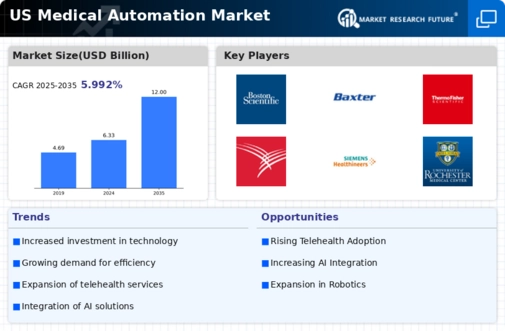The US Medical Automation Market has emerged as a critical segment within the broader healthcare landscape, characterized by rapid advancements and increased adoption of technology aimed at improving efficiency, accuracy, and patient outcomes. The competitive dynamics in this market are shaped by various factors such as innovation in medical devices, software solutions, and comprehensive automation systems designed for diagnostics, treatment, and patient management. Companies operating in this space are continually evolving their offerings to address the pressing demands of healthcare providers, patients, and regulatory bodies, thus contributing to an increasingly competitive environment.
Emerging trends such as telemedicine, artificial intelligence, and data analytics are paving the way for new entrants, while established players are focused on refining their technologies and expanding collaborations to enhance their market position.
Medtronic has established a significant presence in the US Medical Automation Market, showcasing its strengths through a diverse portfolio of medical devices and automation solutions that cater to various healthcare sectors. The company’s robust research and development efforts have enabled it to launch innovative products that streamline procedural workflows and improve clinical efficiency. Medtronic's commitment to quality and safety, coupled with its recognized brand reputation, positions it as a key player in the industry.
Moreover, the company’s strategic partnerships and collaborations with healthcare institutions enhance its market reach, enabling it to respond efficiently to the evolving demands of the healthcare landscape in the US.
Boston Scientific is another formidable competitor in the US Medical Automation Market, known for its extensive range of medical devices and therapeutic solutions. The company has made significant inroads by offering cutting-edge technologies that span areas such as cardiovascular, rhythm management, and pain management, among others. Boston Scientific's strong market presence is further bolstered by its continuous dedication to innovation and customer-centricity, delivering products that address critical healthcare challenges. The company's strategy includes a focus on mergers and acquisitions, allowing it to broaden its product pipeline and enter new markets, enhancing its competitive edge.
Key products such as advanced catheters and automation solutions demonstrate its commitment to improving patient outcomes, while its ongoing research initiatives are geared towards next-generation technologies that are expected to further strengthen its position in the US market.



















Leave a Comment